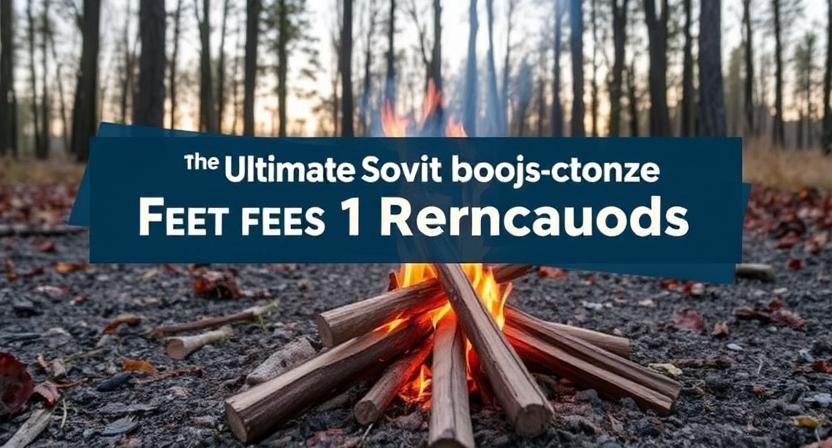The Ultimate Guide to Choosing the Best Firewood for Campfires
Introduction
There’s something undeniably comforting about gathering around a roaring campfire. Whether it’s for warmth, cooking, or simply enjoying the crackle of burning logs under a starlit sky, the type of firewood you choose can dramatically influence the entire experience. From how long the fire burns to the quality of the heat and even the aroma in the air, selecting the right firewood is essential. This guide will walk you through everything you need to know about choosing the best firewood for campfires, helping you make informed decisions that enhance safety, efficiency, and enjoyment.
Understanding What Makes Good Firewood for Campfires
When it comes to campfire wood, not all logs are created equal. What defines good firewood for a campfire is its ability to burn cleanly, provide steady heat, and create minimal smoke. Dense hardwoods often offer longer burn times and higher heat output, while softwoods catch fire quickly and are great for kindling Best Firewood for Campfires. The balance between these two wood types is often the key to building a well-sustained campfire.
Another crucial aspect is dryness. Firewood should be properly seasoned, meaning it has been dried for at least six to twelve months to reduce its moisture content. Wet or green wood leads to excessive smoke, difficulty in ignition, and inefficient burning.
Popular Types of Firewood and Their Characteristics
Among the most highly regarded firewood choices are oak, hickory, maple, cherry, and ash. Each brings a unique set of qualities that influence the burn experience.
Oak is known for its long, steady burn and high heat output. It burns slowly and cleanly, making it a favorite among campers who want a fire that lasts throughout the evening.
Hickory provides one of the highest BTUs among firewood, producing a strong, steady flame with minimal smoke. It also gives off a pleasant aroma, which makes it excellent for campfire cooking and grilling.
Maple, particularly hard maple, burns hot and clean, although it can be slightly more challenging to ignite compared to softer woods. Its coals maintain warmth well, ideal for colder nights.
Cherry not only delivers moderate heat but is also prized for its sweet fragrance. It’s especially enjoyable when used for leisure campfires and adds a soothing ambiance to any campsite.
Ash is a consistent performer. Even when only partially seasoned, it burns well and emits a neutral aroma, offering a reliable heat source for cooking and comfort.
On the other hand, pine and other resinous softwoods are great for starting fires but not ideal for maintaining them. These woods ignite quickly but burn rapidly, often producing excess smoke and soot due to their high sap content.
Heat Output and Efficiency Considerations
One of the key metrics when evaluating firewood is the British Thermal Unit (BTU) rating, which indicates the amount of heat a specific wood type can produce. Hardwoods generally have higher BTU values, meaning they release more energy as heat and burn longer. This is especially important in outdoor settings where maintaining a consistent fire is vital.
Efficient firewood should produce strong coals and minimal creosote. Creosote is the tar-like residue that builds up in chimneys or campfire pits, potentially becoming a fire hazard if not managed properly. Woods that burn too quickly or incompletely can contribute to creosote accumulation.
The Role of Aroma and Smoke Quality in Firewood Selection
For many campers, the aroma of a fire is as important as the heat it provides. Certain woods emit distinctive fragrances that can transform the atmosphere of a campsite. For example, fruitwoods like apple and cherry produce a mild, sweet scent that enhances outdoor meals and relaxation. Hickory delivers a bold, smoky aroma that pairs beautifully with cooking meat over an open flame.
Avoid using woods with strong, unpleasant odors or those that emit toxic fumes. Woods like eucalyptus or treated lumber can release harmful chemicals when burned and should never be used in campfires.
Smoke quality also plays a vital role. Excessive smoke can irritate eyes and lungs, especially in close campfire settings. Properly seasoned hardwoods produce clean-burning fires with minimal smoke, ensuring a more enjoyable and healthier experience for everyone around.
Moisture Content and Seasoning: Why Dry Wood Matters
Moisture content in firewood dramatically affects how it burns. Green wood, which is freshly cut and not dried, typically has moisture levels above 50%. This makes it difficult to ignite and results in a smoky, inefficient fire.
Seasoned wood, on the other hand, contains 20% moisture or less. It burns cleanly, efficiently, and with more heat output. To ensure firewood is adequately seasoned, look for visible cracks in the ends of the logs, a lighter weight compared to green wood, and a hollow sound when two pieces are knocked together.
If you’re unsure about moisture content, using a moisture meter can provide accurate readings and help you avoid firewood that’s not ready to burn.
Sourcing Firewood Responsibly and Locally
Sustainability and legality are key when sourcing firewood. Purchasing wood locally not only supports nearby economies but also helps prevent the spread of invasive pests. Transporting firewood across regions can introduce harmful insects like the emerald ash borer, which devastates native tree populations.
Many parks and campgrounds prohibit bringing outside firewood for this very reason. Always check local regulations before heading out. Some areas provide approved wood onsite or specify which types can be brought in safely.
If you’re cutting your own wood, ensure it’s done in accordance with local guidelines. Use fallen trees or deadwood where permitted and avoid cutting live trees or collecting wood from protected lands.
Environmental and Safety Considerations
Campfire safety begins with choosing the right firewood. Burning non-treated, natural hardwoods reduces pollution and minimizes health risks. Avoid using pressure-treated wood, plywood, or anything painted, as these materials can emit dangerous fumes.
Make sure your fire is built within designated fire rings or pits, away from overhanging branches or dry brush. Keep water or a fire extinguisher nearby in case the fire needs to be doused quickly.
Never leave a fire unattended, and ensure it’s fully extinguished before sleeping or leaving the site. Embers can remain hot for hours and potentially reignite with wind. Douse the fire thoroughly and stir the ashes to ensure no heat remains.
Environmentally conscious campers also consider the sustainability of the wood they burn. Responsibly harvested firewood, whether purchased or collected, helps maintain forest ecosystems. Reputable suppliers will often certify that their wood comes from managed forests or cleared storm debris.
Common Mistakes to Avoid When Choosing Firewood
Campers sometimes make the mistake of selecting wood based solely on price or availability. While convenience is important, using poor-quality wood can result in a frustrating campfire experience.
Another frequent error is underestimating the importance of dry wood. Even high-quality hardwoods will perform poorly if they are not properly seasoned. Campfires built with damp logs will smoke excessively, burn unevenly, and create a challenging environment for cooking or warmth.
Improper storage can also affect firewood quality. If you’re bringing your own supply, store it in a dry, ventilated space and avoid stacking it directly on the ground, where it can absorb moisture.
Enhancing the Campfire Experience with the Right Firewood
The right firewood not only provides warmth but also enhances the overall ambiance of your camping trip. Whether you’re toasting marshmallows, grilling dinner, or simply enjoying the night sky, high-quality firewood makes the experience smoother, cleaner, and more enjoyable.
Consider pairing different woods for optimal results. Use softwood kindling to ignite the fire quickly, then transition to dense hardwoods for a sustained burn. Mix in aromatic woods to elevate the sensory atmosphere. This strategic approach ensures you get the most from your campfire with minimal effort and maximum enjoyment.
Conclusion
Choosing the best firewood for campfires is more than just grabbing the nearest pile of logs. It involves thoughtful consideration of burn quality, moisture content, aroma, safety, and environmental impact. By selecting seasoned, locally sourced hardwoods and avoiding harmful or inappropriate materials, you can create a fire that is efficient, enjoyable, and responsible.
Whether you’re a seasoned outdoor enthusiast or a first-time camper, understanding your firewood options sets the stage for memorable, warm, and safe evenings around the fire. Prioritize quality and preparation, and your campfire will become a reliable companion for every outdoor adventure.






